Rain Water Harvesting In Myanmar
By Marianne de Nazareth
20 January, 2015
Countercurrents.org
"Just like the difficulties you face in India for water, we in Myanmar are facing the same issues," said an elegant and sweetly smiling Professor Dr Khin Ni Ni Thein. We met at the 2015 UN Water, Annual International Zaragoza Conference, and learnt that Professor Dr Khin Ni Ni Thein is the Founder President of the Water Research and Training Centre (WRTC) and is also the Secretary General Academic Management Board, Institute for Civil, Earth and Water Engineering (ICEWE) in Myanmar .
" Water availability and use is an important issue that we face on a daily basis in Myanmar and like in India we are working a lot in the rural areas to help the poor use methods to alleviate their suffering without fresh water being easily available, " she explained.
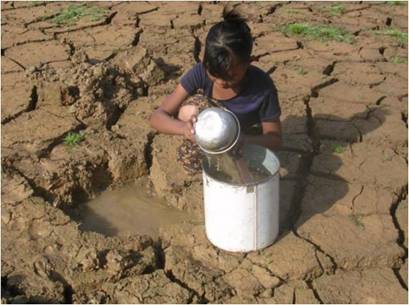
The poor suffer the most in any country, including Myanmar
Talking to her she explained that, the prime source of water in Myanmar is the precipitation of rain and there are three available water sources in the country : (a) Surface Water (b) Ground Water or Underground Water (c) Rain. These water sources have originated from the precipitate falling in the area. Some precipitates directly reach the natural or artificial water harvesting ponds, lakes, reservoirs, dams, streams and river while some runoffs flow into natural water water harvesters, like ponds and lakes and this is known as Surface water.
The runoffs that are able to percolate into the ground, is called Ground water. The rain water is directly received from the precipitate, which percolates into the water table below the ground. This is called Ground water which is being tapped in Myanmar today by bores and pressure pumps.
In Myanmar Professor Dr Khin explained the common water usage patterns: (a)Domestic use –Bathing, Washing, Flushing, Cooking, Drinking (b)Garden watering use (c)Fire fighting (d)Industrial use (e) Commercial use (f)Agricultural use (g)Unaccountable or losses while transporting water.
The Engineering Department (Water Supply and Sanitation) under Yangon City Development Committee (YCDC) of Yangon Regional Government is solely responsible for the provision of the domestic water for Yangon residents. YCDC is providing the water to the six downtown townships, townships near-by downtown and some sub-urbans from water sources of tube wells, Inya and Kandawgyi lakes, Gyobyu , Lwaygar and Phugyi impounding reservoirs and Ngamoeyeik dam. The unserved areas by YCDC is normally handled by people drilling their own tube well individually in their compound. Some are buying the water from water vendors and tankers like in India who use this difficult situation to their own advantage by overcharging.
Similarly , for Mandalay which is the third capital city, Mandalay City Development Committee (MCDC) has being made similar to YCDC for the provision of the domestic water for Mandalay residents, from water sources of tube wells, Nandawshte lake,Yeni stream, and the Kindar and Sedawgyi dams.
Interesting to learn that in Nay Pyi Taw of the first capital city of Myanmar , the Nay Pyi Taw Development Committee (NDC) is completely responsible for the provision of domestic water and in commercial complexes. The water is provided from the water sources of tube wells, the Mingalar lake and reservoirs and the Ngalite dam and this water is distributed to all consumers.
However Professor Khin said that since the people of Myanmar have very high water consumption patterns, they have begun rain water recharge schemes all over the country. This is because looking at the near future, and the future of the next generation due to over-pumping of ground water and surface water, RWH is of prime importance.
"Recent issues of drought and Climate Change, and finally the grim scenario of water scarcity, we realise RWH should be done at every household level," she said.
The diagram below gives you a clear idea of what has to be done in every household to capture and conduct their own RWH for their own private use. The initial expense is there for the gutter and the pipe with the tank below, but it finally is a great help for homes suffering from water scarcity. This is because Rain water is the most pristine form of water.
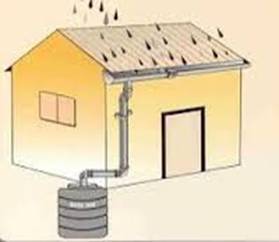
Diagram of RWH mechanism for a single home.
" Just like in India with thatched roofs, we too have huts with thatched roofs in Myanmar . Look at the picture below you can see the thatched huts in a village and here the gutters are made of hollowed and split bamboo and a cheap tank below which can be made of a container lined with tarpaulin. The villagers are very poor and cannot afford expensive commercial equipment.
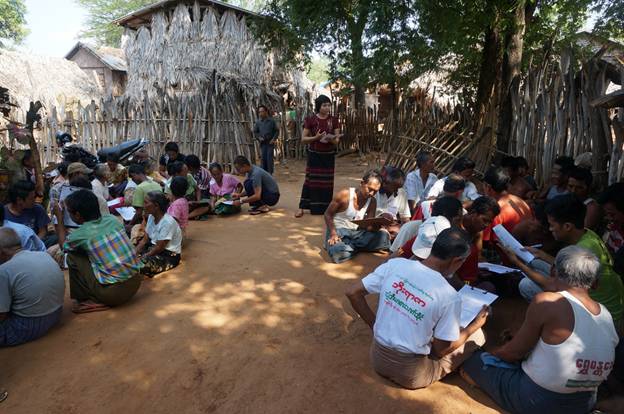
Villagers sitting around a talk being given on RWH in Myanmar
There are a number of NGO's helping in Myanmar . Proximity Designs, formerly known as International Development Enterprises Myanmar (IDE|M), believes that even the poorest of the poor can be enterprising entrepreneurs, if they are given proper tools. Their designs manufactures affordable income-generating and money-saving products that help smallholder households in Myanmar/Burma, pull themselves out of poverty. The organization partners with local manufacturers, retailers, and village agents to distribute their products to customers at the lowest possible price.
Recently IDE have introduced a prefabricated tank made of tarpaulin (3 X 3 X 3 ft), see below, mounted in a bamboo frame together with a collector tarpaulin. This tank collects water for up to a maximum 5 families, to share water from. This could be an alternative and other, larger, collection buckets and tanks can be used. Tarpaulin is available in rolls (100 yards long and 6 ft wide; approximately 90 metres long and 1.8 m wide), and could be pre-cut or cut to length in situ. Any container and plastic sheeting used for collecting and storing drinking water should be throughly cleaned before being used. This should be done as per instructions in the Purification should be done at household level and in accordance with the adopted chlorination guidelines.
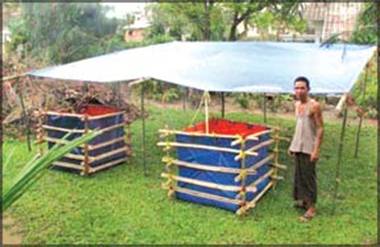
A simple tarpaulin stretched over a frame with cheap tarpaulin tanks to collect and RWH
" Digging the soil in fields helps the water to stand and percolate into the soil and increase the ground water table," says Jeff D'Lemos a RWH specialist based in Bangalore . "This is a method which can be used all across the world to save precious precipitate and rain water, rather than losing it by run off," he says. The picture shows a happy farmer in Myanmar digging up his field to encourage the rain to seep down into the soil rather than run off into gullies, taking the precious top soil with it.
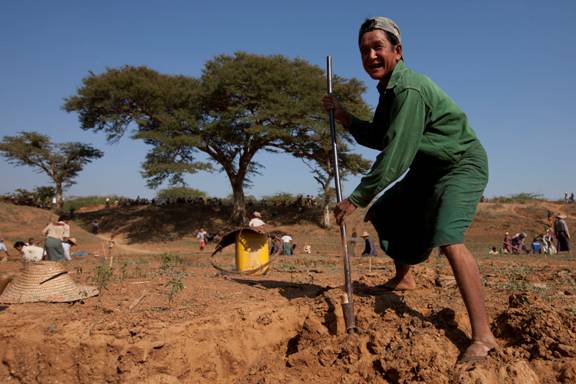
Farmers in Myanmar being encouraged to dig up the soil in their fields, to encourage seepage of precious rainwater, into the ground water table.
In the event that rainwater from existing ponds is used for human consumption, sedimentation is normally required, and it is recommended that is carried out in the household storage containers, which should be large.
There are several types of RWH ponds in the villages of Myanmar , of which some are especially designed to handle storage only of drinking water. The pond walls can be as high as 6 ft., and are normally protected so that domestic animals cannot enter them and pollute them. This protection is crucial and needs to be adhered to strictly.
Important points made by Professor Thein was that if working in a village to educate the villagers about water:
• Always engage the local community in the work, they are by tradition harvesters of the rain.
• Chlorination directly in the pond is not recommended.
• Rainwater catchment is often the only source of water when all water is saline.
( Marianne de Nazareth is a Freelance science and environment journalist and adjunct faculty, St Joseph's College of Media studies, Bangalore and PhD scholar in MKU. )
.
Comments are moderated

